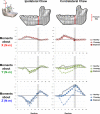Fracture Fixation Technique and Chewing Side Impact Jaw Mechanics in Mandible Fracture Repair
- PMID: 35079674
- PMCID: PMC8770999
- DOI: 10.1002/jbm4.10559
Fracture Fixation Technique and Chewing Side Impact Jaw Mechanics in Mandible Fracture Repair
Abstract
Lower jaw (mandible) fractures significantly impact patient health and well-being due to pain and difficulty eating, but the best technique for repairing the most common subtype-angle fractures-and rehabilitating mastication is unknown. Our study is the first to use realistic in silico simulation of chewing to quantify the effects of Champy and biplanar techniques of angle fracture fixation. We show that more rigid, biplanar fixation results in lower strain magnitudes in the miniplates, the bone around the screws, and in the fracture zone, and that the mandibular strain regime approximates the unfractured condition. Importantly, the strain regime in the fracture zone is affected by chewing laterality, suggesting that both fixation type and the patient's post-fixation masticatory pattern-ipsi- or contralateral to the fracture- impact the bone healing environment. Our study calls for further investigation of the impact of fixation technique on chewing behavior. Research that combines in vivo and in silico approaches can link jaw mechanics to bone healing and yield more definitive recommendations for fixation, hardware, and postoperative rehabilitation to improve outcomes. © 2021 The Authors. JBMR Plus published by Wiley Periodicals LLC on behalf of American Society for Bone and Mineral Research.
Keywords: FINITE ELEMENT ANALYSIS; IMPLANTS; MANDIBLE; MASTICATION; MAXILLOFACIAL SURGERY; RHESUS MONKEY; TRAUMA.
© 2021 The Authors. JBMR Plus published by Wiley Periodicals LLC on behalf of American Society for Bone and Mineral Research.
Figures






References
-
- Ellis E, Moos KF, El‐Attar A. Ten years of mandibular fractures: an analysis of 2,137 cases. Oral Surg Oral Med Oral Pathol. 1985;59:120‐129. - PubMed
-
- Kopp RW, Crozier DL, Goyal P, Kellman RM, Suryadevara AC. Decade review of mandible fractures and arch bar impact on outcomes of nonsubcondylar fractures. Laryngoscope. 2016;126:596‐601. - PubMed
-
- Owens BD, Kragh JF, Wenke JC, Macaitis J, Wade CE, Holcomb JB. Combat wounds in Operation Iraqi Freedom and Operation Enduring Freedom. J Trauma. 2008;64:295‐299. - PubMed
-
- Zachar MR, Labella C, Kittle CP, Baer PB, Hale RG, Chan RK. Characterization of mandibular fractures incurred from battle injuries in Iraq and Afghanistan from 2001‐2010. J Oral Maxillofac Surg. 2013;71:734‐742. - PubMed
LinkOut - more resources
Full Text Sources
